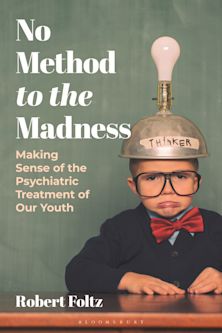- Home
- ACADEMIC
- Psychology
- Psychopathology & Clinical Psychology
- Understanding Paranoia
Understanding Paranoia
A Guide for Professionals, Families, and Sufferers
Understanding Paranoia
A Guide for Professionals, Families, and Sufferers
This product is usually dispatched within 1 week
- Delivery and returns info
-
Free CA delivery on orders $40 or over
You must sign in to add this item to your wishlist. Please sign in or create an account
Description
In this insightful book, the author vividly takes the reader inside the minds of people who are paranoid: experiencing delusions of persecution ranging from thinking others are out to get them to falsely believing they have physical illness. Kantor also explains to us other facets of the Paranoid Personality, including suspiciousness, hypersensitivity, extreme vigilance, simmering anger, and a tendency to blame others for and absolve oneself of almost everything. How does such paranoia affect one's life? Whether one is a paranoiac wanting to recover from the emotional disorder, or a person looking for the best way to deal with a paranoid husband, wife, friend, boss, or acquaintance, this book offers understanding and guidance. As Kantor explains, the term paranoid should not be used as a hurtful epithet. Paranoid individuals are no more or less evil than persons with any other emotional disorder, or for that matter, persons with a physical disorder. Paranoia is a disorder of the mind, not a flaw of character, says Kantor.
Paranoid individuals are not invariably social misfits. They are found in all walks of life and in all professions, suffering from this disorder that distorts behavior and affects those with whom they come in contact, often in devastating ways. Politicians who write attack ads, spouses who beat or kill their partners, people in road or supermarket rage incidents are all among the possibly paranoid, as are students who perpetrate violence at their schools and fired employees who wreak violence at their former workplaces. Recognizing and treating paranoid behaviors can prevent or reduce antisocial activity and violence against individuals and society.
Table of Contents
Description
Some Prominent Characteristics of Paranoid Individuals
Delusional Disorder
Paranoid Personality Disorder
The Adverse Ways Paranoid Individuals Affect Others
Covert (Hidden) and Missed Paranoia
The Gray Area and the Paranoia of Everyday Life
Interpersonal-Social Aspects of Paranoia/Paranoid Violence
Forensic Issues
Cause
The Roles Society and the Family Play in Causing Paranoia
Psychodynamic Causes
Cognitive-Behavioral Causality
Therapy
Psychodynamic/Interpersonal Approaches
Cognitive-Behavioral Therapy
Affirmative Psychotherapy
Pharmacotherapy
Therapeutic Cautions, Caveats, and Errors
Prognosis
Self-Help
Ways Caretakers Can Deal Effectively with the Paranoid Individuals in their Lives
Things to Avoid Doing with Paranoid Individuals
Coping with One's Own Paranoia
Product details
| Published | Jun 30 2004 |
|---|---|
| Format | Hardback |
| Edition | 1st |
| Extent | 272 |
| ISBN | 9780275981525 |
| Imprint | Praeger |
| Dimensions | 235 x 156 mm |
| Publisher | Bloomsbury Publishing |
About the contributors

ONLINE RESOURCES
Bloomsbury Collections
This book is available on Bloomsbury Collections where your library has access.


































